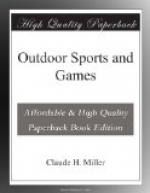To become an expert photographer and one whose work will be worth while, we must really make a study of the subject. The modern outfits and chemicals make it very easy for us if we do our part.
The basis of successful work is a good lens, which is really the eye of the camera. In selecting it we should get just as good a one as we can afford. There are a great many excellent makes of lenses on the market and even the stock types that are supplied with moderate-priced cameras are of very good quality. The two distinct types of lenses are the “rapid rectilinear” and the “anastigmatic,” which names refer to their optical properties in distributing the light. For our purpose all we need to know is that the higher price we pay the better our lenses will be, and in addition to this the further fact that the best kind of results can be obtained by any lens provided that we do not try to force it to do work for which it is not adapted.
To understand photography we must first of all get a clear notion of the use and purpose of the stops, as the various openings or apertures are called that the lens is provided with. A “fast” lens is one that will give a sharp picture at a maximum opening, and such lenses are both the most expensive and the most universal in their application. Lenses of this class are used in making instantaneous pictures with very rapid exposures, and for ordinary view or portrait work will produce no better results than much slower and less expensive types.
Perhaps the best way to understand photography as an art rather than a “push the button” pastime is to take up the process of making a picture step by step. To begin with, the real photographer will use plates instead of films, as much better pictures usually are possible by their use. Dry plates come a dozen in a box, usually packed face to face—that is, with the film or sensitive sides facing. The plate-holder must be loaded in a dark room or dark closet, with absolutely no exposure to daylight or any artificial light whatever except a very faint light from a dark-room lantern, a combination of ruby and yellow glass or paper. We should always test our dark room and light by means of a plate before we trust them to actual working conditions. Take a fresh plate and cover it half with a piece of cardboard, or if it is in a holder draw the slide half way out and allow the dark-room light to strike it for five minutes, then develop the plate just as you would an exposed negative, and if the test plate shows the effect of the exposure and darkens, we shall need to make our light safer either by adding a sheet or two of yellow or ruby paper or we must examine our room carefully to stop up any cracks where rays of white light may enter. We must remember that a plate sensitive enough to record instantaneous exposures of 1-500 of a second must be sensitive to any tiny ray of outside light also. Almost any room will make a dark room, especially if it is used at night.




